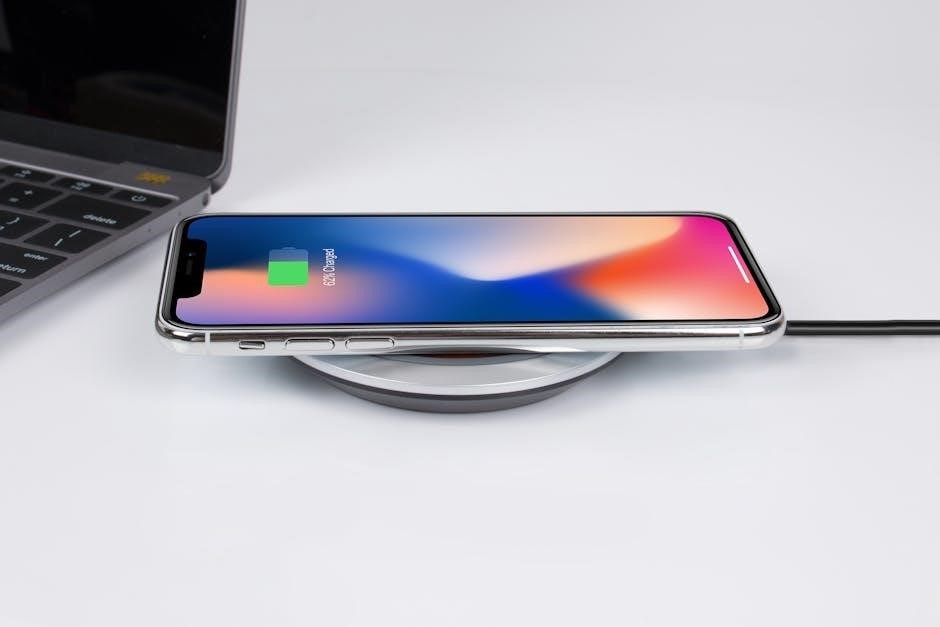Welcome to the CAT Battery Charger Manual! This guide provides essential information for safe and optimal use of your charger, ensuring extended battery life and reliable performance.
1.1 Overview of the CAT Battery Charger
The CAT Battery Charger is a high-efficiency charging solution designed for CAT batteries, ensuring optimal performance and longevity. It features advanced charging technology, compatibility with various battery types, and a user-friendly interface. The charger is built with safety and durability in mind, making it a reliable choice for both professional and personal use. Its compact design and intuitive controls simplify the charging process, while its robust construction withstands demanding environments. This charger is an essential tool for maintaining your CAT battery’s health and performance.
1.2 Importance of Proper Charger Usage
Proper use of the CAT Battery Charger is crucial for ensuring safety, optimal performance, and extending battery life. Incorrect charging methods can lead to overcharging, battery damage, or even safety hazards. Adhering to the guidelines ensures efficient energy transfer, prevents overheating, and maintains the battery’s health. Proper usage also safeguards against electrical hazards, making it essential to follow the manual’s instructions carefully for reliable and long-term functionality of your CAT battery and charger system.
Key Features of the CAT Battery Charger
The CAT Battery Charger offers advanced charging modes, LED indicators, and compatible battery specifications, ensuring efficient and safe charging for optimal performance and extended battery lifespan.
2.1 Battery Specifications and Compatibility
The CAT Battery Charger is designed to work with a variety of battery types, including deep-cycle and AGM batteries; It supports a wide range of capacities, from 40Ah to 200Ah, ensuring compatibility with most vehicles. The charger delivers a maximum current of 10A, making it suitable for both small and large batteries. Its advanced circuitry ensures safe and efficient charging, maintaining optimal voltage levels to prevent overcharging. This versatility makes it a reliable choice for different user needs.
2.2 Charging Levels and Modes
The CAT Battery Charger features multiple charging levels and modes to cater to different battery needs. It includes a fast charging mode for quick top-ups and an eco mode for energy-efficient charging. The charger also offers a trickle charge mode to maintain battery health during long storage periods. With automatic voltage adjustment, it ensures safe and optimal charging for various battery types. These modes are designed to enhance performance, safety, and battery lifespan, providing users with flexibility and reliability.
2.3 LED Indicators and Display Functions
The CAT Battery Charger features LED indicators that provide real-time feedback on charging status. The green LED indicates a fully charged battery, while the red LED shows active charging. A yellow LED signals standby or fault detection. The digital display shows voltage, current, and charging percentage, ensuring precise monitoring. These visual cues and data displays help users track charging progress and identify potential issues promptly, enhancing safety and efficiency.

Safety Precautions and Guidelines
Ensure safe operation by following guidelines: avoid overcharging, keep the charger away from flammable materials, and prevent children from handling the device. Always wear protective gear.
3.1 General Safety Tips for Battery Charging
When charging, ensure the area is well-ventilated to prevent gas buildup. Avoid overcharging, as it can damage the battery and reduce its lifespan. Keep flammable materials away and never leave the charger unattended. Always disconnect the battery before starting work. Wear protective gloves and eyewear. If unsure, consult the manual or seek professional help. Proper handling ensures safety and efficiency for both the charger and battery.
3.2 Warning Signs to Avoid Overcharging
Monitor the battery voltage; if it exceeds 15V, stop charging immediately. Look for swelling or bloating in the battery case, which indicates overcharging. Unusual heat, hissing sounds, or leaking fluids are also warning signs. Always set your charger to stop at 80% if possible to preserve battery health. Regularly check charging time and adjust settings to prevent overcharging, ensuring longevity and safety for your CAT battery charger and battery.
3.3 Proper Handling of the Charger and Battery
Always handle the CAT battery charger and battery with care to avoid damage. Ensure the charger is placed on a stable, heat-resistant surface. Keep the battery away from direct sunlight and flammable materials. Avoid touching electrical components with wet hands. Store the charger and battery in a cool, dry place when not in use. Regularly inspect for signs of wear or damage and replace if necessary. Proper handling ensures safety and optimal performance.
Installation and Setup
Installation and setup are crucial for ensuring your CAT battery charger functions correctly. Follow safety guidelines and manufacturer recommendations to secure a stable and efficient charging system.
4.1 Step-by-Step Installation Guide
Begin by ensuring the charger is placed on a stable, flat surface away from flammable materials. Connect the charger to a power source using the provided cord. Next, attach the positive and negative terminals to the battery, ensuring correct polarity. Secure all connections tightly. Refer to the manual for specific voltage settings and charging modes. Always wear protective gloves and eyewear during installation. Follow these steps carefully to ensure safe and effective charging. Proper installation is key to long-term performance and safety.
4.2 Initial Setup and Configuration
After installation, turn on the charger and select the appropriate charge mode using the control panel. Set the voltage and current according to the battery specifications. Ensure the charger is configured for the correct battery type, such as lead-acid or lithium. Check the LED indicators to confirm proper setup. Once configured, press the start button to begin charging. Monitor the process to ensure it operates smoothly and safely. Proper configuration is essential for optimal charging performance. Always refer to the manual for specific settings.

Usage and Maintenance
Proper usage and regular maintenance ensure optimal performance and longevity of your CAT battery charger. Follow guidelines for daily charging and routine checks to maximize efficiency and safety.
5.1 Daily Use and Charging Best Practices
For optimal performance, charge your battery when it drops to 20% capacity. Avoid overcharging by setting limits, typically between 80-100%. Use the charger in well-ventilated areas, away from flammable materials. Keep the charger and battery clean, ensuring all connections are secure. Regularly inspect cables for damage and replace them if necessary. Proper storage in a cool, dry place enhances longevity. Always follow the manufacturer’s guidelines for charging times and modes to prevent degradation and ensure safety.
5.2 Regular Maintenance for Optimal Performance
Regularly inspect the charger and battery for signs of wear or damage. Clean terminals and connections to ensure proper conductivity. Check for loose wires and tighten them as needed. Store the battery in a cool, dry place to prevent degradation. Avoid extreme temperatures, as they can affect performance. Update the charger’s software periodically to ensure compatibility and efficiency. Proper maintenance extends the lifespan and ensures reliable operation of your CAT battery charger system.

Troubleshooting Common Issues
Identify common issues like error codes or slow charging. Check connections and ensure proper setup. Refer to the manual for solutions or reset the charger if needed.
6.1 Identifying and Solving Battery Charging Problems
Identify issues by checking LED indicators or error codes. Common problems include loose connections or incorrect voltage settings. Ensure the battery is compatible and charging mode is selected. If charging stops, verify the power source; Clean terminals to prevent resistance. Avoid overcharging by monitoring voltage levels. Restart the charger or reset if necessary. Refer to troubleshooting charts for detailed solutions.
6.2 Resetting the Charger and Battery Connection
To reset the charger, disconnect it from the power source and battery for 30 seconds. Reconnect and ensure terminals are secure. If issues persist, check for firmware updates or consult the manual. Resetting restores default settings, resolving connectivity or charging mode conflicts. Always follow safety guidelines to avoid electrical hazards. Regular resets can prevent malfunction and ensure optimal performance. Resetting is a simple yet effective troubleshooting step for maintaining charger efficiency and reliability.
Warranty and Customer Support
Your CAT Battery Charger is backed by a comprehensive warranty. Register your product for extended coverage and access dedicated customer support for troubleshooting and assistance needs.
7.1 Understanding the Warranty Terms
Understand your warranty terms to ensure coverage for repairs and replacements. The CAT Battery Charger warranty typically covers manufacturing defects for a specified period. Proper registration and adherence to usage guidelines are essential for maintaining warranty validity. Damages from misuse or overcharging may not be covered. Review your warranty document for detailed conditions and exclusions to maximize protection for your charger and battery system.
7.2 Contacting Customer Support for Assistance
For any inquiries or issues, contact CAT customer support via phone, email, or live chat. Visit the official website for contact details and support options. Ensure you have your charger model and serial number ready for faster assistance. Representatives are available to address warranty claims, troubleshooting, and general questions. Reach out for expert help in resolving any concerns promptly and efficiently.

Frequently Asked Questions (FAQs)
Explore common questions about the CAT Battery Charger, including compatibility, charging times, and troubleshooting. Find quick answers to ensure optimal performance and user satisfaction.
8.1 Common Queries About the CAT Battery Charger
Users often ask about the CAT Battery Charger’s compatibility with different battery types and its charging capacity. Many inquire about the optimal charge levels to preserve battery health, similar to EV drivers who stop charging at 80%. Others seek clarity on LED indicators, charging times, and troubleshooting common issues like overcharging, which can be identified by voltage levels exceeding 15V. These FAQs aim to address such concerns clearly.
8.2 Addressing User Concerns and Misconceptions
Some users believe that constant charging harms batteries, but the CAT Charger features overcharge protection. Others think higher voltage speeds up charging, yet it risks damage. A common misconception is that all batteries are compatible, but only specific types work; Clarifying these ensures safe, efficient use and extends battery life, aligning with best practices from EV drivers who avoid full charges to prevent degradation.
By following this manual, you ensure safe and efficient battery charging, extending the lifespan of your CAT Battery Charger and battery while maintaining optimal performance.
9.1 Summary of Key Takeaways
9.2 Final Tips for Extended Charger Lifespan
To maximize your CAT Battery Charger’s lifespan, store it in a cool, dry place when not in use. Avoid extreme temperatures and ensure the charger is unplugged during extended storage. Regularly inspect cords for damage and avoid overloading circuits. Update firmware if available and use genuine CAT accessories to maintain compatibility. Proper care and adherence to guidelines will ensure your charger remains efficient and reliable for years to come.

